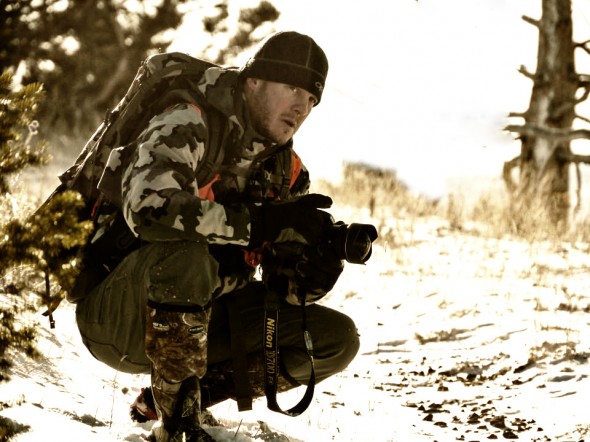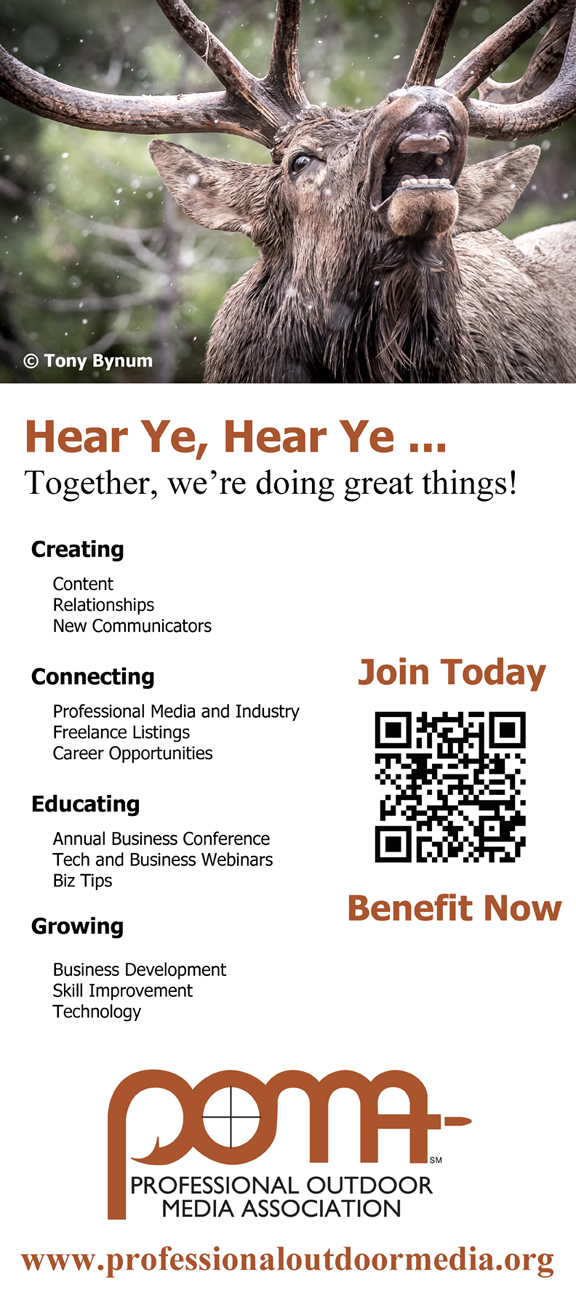How to Ruin an Outdoor Photography Career with One Email
"My photographs have better colors than the one's you're using on the covers of your magazines. . . when you're ready to work with a real professional, give me a call" - source: unnamed "professional" photographer. Those are the paraphrased words from a real freelance photographer to a magazine editor asking if the editor would consider his work for publication. After the initial request, the editor politely told him that the content he uses is supplied mainly in-house, and therefore they were not accepting freelance or unsolicited photographs at this time. Following the editors reply, the photographer obviously felt it necessary to basically tell the editor that their stuff sucked, and then recommend to him, that he's the real pro. . .
What the photographer wrote in that email sounds absurd, right? Most of you would agree that it should go without saying that you don't start a new business relationship by telling those that you want to work with, they suck, but obviously it happens. I'm here to tell you, using that kind of language will not only get you nowhere, it will get you there fast, especially in a business community as small and tight as ours.
As a professional outdoor photographer myself, a photo editor, and contributor to many of the popular outdoor publications you've grown up with, and a pile of the more recent ones, how likely do you think I will be to consider using that guys photos, or refer him to someone else, or support him when someone calls me to verify his professionalism? Being confident and self-assured is one thing, but trashing the editor by telling them they need to work with a real pro, is nuts!
The professional outdoor media world is a relatively small industry. People know each other and share information about whose good, and what works and what doesn't, all the time. I'm not saying you have to toe-the-line or you won't make it. You should certainly chart your own course. But telling a magazine editor that their covers suck and that you're available if he/she needs a real professional, is a sure way to ruin your career.
So how do you make it in this business? Many people have found a mentor, or worked as an intern for an existing, well established individual professional or company. After getting the requisite experience, some branch out on their own and become a freelancer or start their own companies. The other way to do it is to just gut it out and work your butt off to create great content, and an even better markenting strategy.
A friend of mine, Stephanie Mallory, of Mallory Communications, and fellow member of the the Professional Outdoor Media Association (POMA), wrote a great article talking about her own experience and included a few citations and comments from others like Bill Konway, John Phillips, Michael Waddell, J. Wayne Fears, and Chad Schearer, describing briefly how they managed to, "make it" in the traditional outdoor media world. By Stephanie's estimation, it sounds like no matter what route you take you have to learn how to be a professional and work hard! I would agree.
I guess the moral of this story is that in order to become a professional, you must first learn how to act like one. Your first step should be to join an outstanding professional organization like the Professional Outdoor Media Association (POMA) - you can find us on Twitter @poma_hq, or contact me directly with by commenting on this post, or shoot me a tweet @tonybynum.
POMA's Mission @poma_hq simply put, is:
We are having our annual conference March 6-9th 2013 in Columbia South Carolina, here are the details, "Professional Outdoor Media Association Annual Conference."
Sincerely, Tony Bynum
Twitter: @tonybynum
facebook.com/tonybynumphotography
#MustFollowMonday - @tonybynum Always sharing interesting content. Photographer, key player in outdoor industry.
— Cam Pauli (@CamPauli) February 11, 2013
Dig Deep to Achieve - go to college you snob!
Being an adventurer, and nature, wildlife and commercial outdoor photographer does not take a Harvard education - I’m proof of that. I turned my passion for photography into my life’s work and only source of income without ever taking a single course or class about the subject of business or photography. But, I did put myself though college. There’s no doubt in my mind that an education opens doors and creates options. I would be greatly handicapped if not for my college experiences, and if I had to do it over again, I would have taken some business courses!

People should understand that working hard and digging deep is the key to success (a break now and then helps too). I love outdoor photography. I love nature photography. I love to photograph wild animals in their natural habitat. And there are few things that inspire me more than creating images of great places, people and adventures.
Imagine how much effort it really takes to be a successful nature, wildlife and commercial outdoor photographer. It’s not the education that gets you up and out the door at 5 A.M. No one is there to tell you to punch the time clock and there’s no annual review that grants you a cost of living or step increase. As a nature, wildlife and commercial outdoor photographer, you have to take risks and you have do things that other’s either can’t or won’t do.
For me, digging deep is not a choice, it’s just an obsession. I have found success in most things I’ve done because I always try to move forward and take chances. I think photography, good photography is really an orchestra of ignorance, wisdom, education, motivation, experience and drive that play together at various levels throughout our lives. It is up to the individual to direct the energy and organize the emotions and actions.
I encourage anyone who wants to become a photographer to study and go to college. Don’t just study photography, study math, science, geography, biology, resources management, accounting, art, and camping . . . yes, camping! Study furniture making and the art of bending wood. Pay attention to the world around you and move in the direction that moves you.
The truth is, it’s not the college degree that makes the real difference, it’s what you do with what you learn along the way and how you apply it all that makes success possible. The journey and what you do with it is what matters. The learning helps us acquire the skills that enable us to be more productive. Never be afraid to learn and never be afraid to take risks. . . You never know who’s watching . . . Dig deep to achieve.
How To Make Photographs that Sell - Just Do It!
Your photographs have to speak to people. By speak to them I mean they should help them have an experience, or feel something special in their heart or mind when they view it. The image must draw them into the scene, and cause them to think deeper. Over the past decade of producing wildlife, landscape, and outdoor commercial images for the travel and tourism industry, the outdoor commercial products industry, and editorial sector, I’ve learned something about what makes a salable photograph. But how did I create them?
My most successful images, and by success I mean in sales, have come about when I just let it all hang out. When I’m in the field, I’m exploring with my mind and soul. I find that I create the most compelling images when my purpose is to learn. Sure, I create images while on assignment, in which case there is always a theme or subject and therefore I have to create images that capture the essence of the project, but I find that I do my best work when I’m in my “zone.” When I’m just “freelancing” the environment around me. Whether I’m on an assignment in the middle of a rugged landscape shooting commercial products, or whether I'm shooting landscapes, or wildlife for my stock library, my best images come when my mind is clear and I’m exploring.
The key to exploring is to be open minded while still having purpose (I know this sounds like an oxymoron but it's essential). My purpose is to learn more about the land and the people and critters who use it. I explore and learn first, then create images that I believe are compelling. I look for those places that have elements needed for a compelling photograph then I learn as much about the place as I can. It’s like hunting, you have to look, listen, smell, and most of all, pay attention. You have to be in tune with the place and to do that, your mind has to be free. You must be able to ignore the “noise” and focus on the subject.
Here’s an example. This image is pasted across the nation in magazines, on the sides of buses, elevator doors, billboards, skylights, and even entire store fronts in major cities like Chicago, Minneapolis and Seattle. It is being used to brand the state of Montana and it's the cover of the 2012 Montana Guide.
To me it’s a magical image. I captured it while I was exploring a place I've been to 100 times! But my mind was open and clear and my purpose was to expose an image that could be used to show people the beauty of a place I cherish. I did not go there thinking, "I must come home with a great photograph." Instead I went out thinking, "I want to really see what's here." Sounds a little philosophical I know, but give it a try.
[photoshelter-img width='420' height='320' i_id='I0000ppWBDPczu0I' buy='1']So the answer to how to create images that sell is, you dig deep, but not too deep, push hard, but not too hard, be aware and focused but not so focused that you ignore the big picture, and remember, keep your mind open, explore, and just do it. If you have questions or comments please share them! I'd love to get your feedback.


